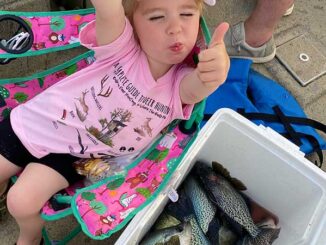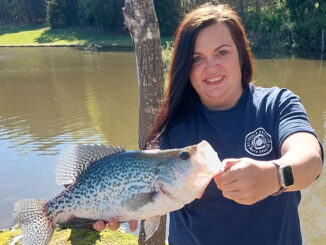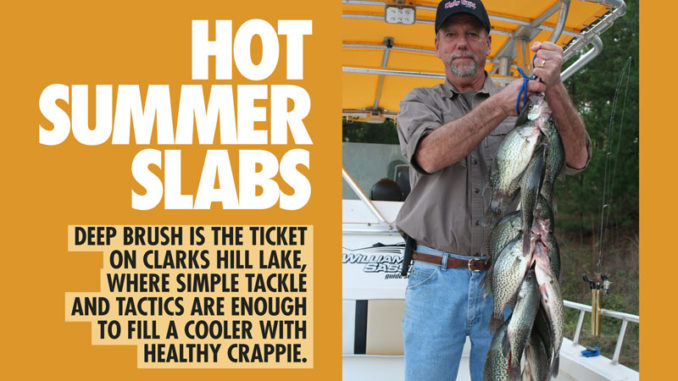
The heat doesn’t stop the crappie bite
Brad Sasser eased the boat into the mouth of a large cove, then, intently watching his sonar, he began an ever-tightening counter-clockwise circle until he had the boat positioned exactly where he wanted it — over a submerged tree in more than 25 feet of water.
He set two anchors, quickly baited a half-dozen rods with small shiner minnows and dropped them down to just above the top of the underwater brush. Soon, a rod tip went down, and a 10-inch crappie was heaved into the boat.
That basically is the story of summer crappie fishing on Clarks Hill Lake, according to Sasser, the third generation of his family to fish the 70,000 acres of the reservoir also known as Thurmond Lake. He guides for his father’s William Sasser Fishing Charters; the two have more than 80 years of experience fishing the lake.
William Sasser said his dad hunted rabbits all over the land that was eventually covered when the lake was impounded in the early 1950s, and he marked locations that he thought would be good fishing spots, such as sawmills and sawdust piles.
“Some of those places were the best crappie-fishing spots after the lake filled,” he said. “Back in Grays Creek, there is a place he named the Sawdust Pile. I could not tell you how many crappie we caught off that place, and we have added trees to it since then.”
Although there are public fish attractors established by the U.S. Army Corps of Engineers, which manages the lake, the Sassers primarily fish spots where they have sunk trees, sometimes entire trees, in depths from 25 to 40 feet deep.
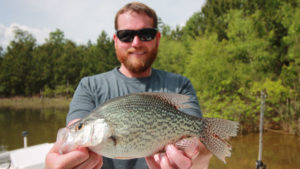
Typically, they sink oaks or other hardwoods because they last longer than other types, like Christmas trees, and they freshen those spots with new brush on a regular basis.
“I don’t think you can be a good crappie fisherman on Clarks Hill unless you take the time and put in the effort to put out trees for crappie habitat. That has always worked for me,” Brad Sasser said.
When fishing these spots, boat positioning is critical, he said.
“If you anchor just 10 feet off the tree, you can be too far from the fish,” he said. “The best thing is to put the nose of the boat in the wind and back over the tree. And it is important to get on the right position on the first try. If you hang the anchor in the tree, you might as well move on to another spot.”
William Sasser believes that most of the best spots for crappie are in the upper half of Clarks Hill Lake.
“I think 75 percent of the crappie in the lake can be found from the Fishing Village area up, in South Carolina Little River from the Little River Bridge up to the pumping station,” he said. “Not that you won’t catch crappie in the lower part of the lake, but your chances are much better in the upper half.”
Although the water temperature can reach the high 80s and even low 90s in July and August, the warmer water is not really a factor when targeting summer slabs, Brad Sasser said.
However, the Sassers take plenty of small shiners when they are crappie fishing this time of year. It’s better to re-bait with a lively minnow than to keep one on the hook that is lethargic in the warm water or has been injured by a missed bite, Brad Sasser said.
The Sassers’ basic crappie tackle includes 8-foot Zebco Crappie Fighter rods and Daiwa 1000B Series spinning reels spooled with 6-pound Mr. Crappie Hi-Viz monofilament. A No. 2 gold Aberdeen hook is tied on the end, below a No. 5 split that provides just enough weight to get the minnow down to the fish.
“I try to stick with the lightest tackle I can use,” Brad Sasser said. “The 6-pound line is strong enough, thin enough and light enough, and it drops really well with the light weight. If you hang the gold Aberdeen hook in the tree, it usually comes out pretty easy. It is a very forgiving hook.”
Sasser said the summer bite is usually very aggressive compared to the more-subtle bite in late spring.
“They hit it pretty good this time of year,” he said.
That is, if they are biting on a certain brush pile.
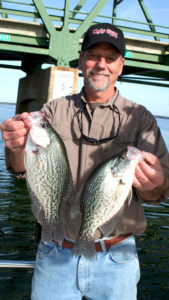
“When you pull up on a hole, if you don’t have a bite in the first 10 to 15 minutes, you might as well move on to another spot,” he said. “If I am on a spot catching fish and the bite slacks off, I’ll wait from maybe 10 to 20 or 25 minutes, and if I don’t get another bite, it’s time to move.”
A typical summer crappie trip might produce a few fish in the pound-and-a-half to 2-pound range, he said, but the catch usually is mostly 10- to 14-inch fish, with some 15 inches or better.
“One thing about brush-pile fishing; you might pull up on a spot and only have 4-inch crappie, but the next spot might be all 12-inch fish.”
Time of day is not a major factor, Brad Sasser said, although he prefers to fish mornings before the sun heats things up.
“If we start about 6:30 to 7 in the morning, we should wrap up with a cooler full of fish about 10 or 10:30,” he said.
As for the best summer crappie fishing he can remember, the younger Sasser thought for a moment before saying, “All the guide trips usually turn out good, but the childhood memories with me, my dad and my grandfather are the ones that really stand out.”
Timing is key for crappie at night
Once popular, fishing at night for crappie has been on the wane at Clarks Hill Lake in recent years, but it is still a good way to catch summer fish, according to guide William Sasser.
There is no question that in July and August, it’s a lot more comfortable to fish in the cooler after-dark temperatures.
The key to success, Sasser said, is to remember that timing is everything. He said the best bite will come sometime between midnight and dawn.
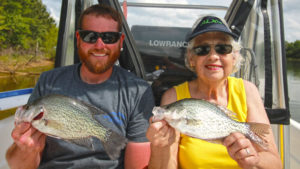
“The good bite never seems to come at 10 o’clock at night. In fact, I have had times when we were wearing the fish out over brush we’d put in the lake, and when the sun got behind the trees late in the afternoon the bite was over,” he said. “They just don’t like the dusk part of night. I’ve put out lights and sat there for three hours or more and decided there was no point in staying out there.”
Sasser said it’s probably best to try to catch a nap early in the evening, then venture out after midnight.
“I would target the traveling crappie around the smaller bridges on the lake, the Raysville Bridge, the bridges across Soap Creek and the other bridges up from mid-lake,” he said, explaining that schools of crappie are on the move, and they travel under those bridges/
“People now are using LED lights at night. They can run all night and not drain the battery,” Sasser said. “Clip one on the front of the boat and one on the back, then fish live minnows about 15 feet down.”
Sasser said it is best to fish the edges of the light pattern on the water, not right under the light. “They tend to hang on the outskirts of the light. They will circle, then dart in to get the bait,” he said.
Destination Information
 How To Get There
How To Get There
US 378 runs from McCormick, S.C., across South Carolina Little River and the Savannah River to Lincolnton, Ga. SC 28 runs along the east side of the the lake from McCormick to the Clarks Hill community. US 221 runs west from Clarks Hill across Thurmond Lake Dam into Georgia, where it picks up GA 47, which crosses Georgia Little River and runs up the west side of the lake to Lincolnton, Ga. For a complete list of boat-access areas, visit: http://stromthurmond.uslakes.info/POI/Boat-Ramps/
When To Go
During summer, it’s more comfortable to fish in the morning before the heat sets in, and the fish do seem to feed better at that time of day. If night fishing, wait until after midnight and plan to fish to daylight.
Best Techniques
Using your boat’s sonar, search the mouths of coves on the main lake or main tributaries for submerged trees and other structure in 25 feet of water. Use medium-action spinning tackle with 6-pound line for fishing brush piles. Tie on a No. 2 gold Aberdeen hook with a No. 5 split shot for live minnows. Small shiners or tuffy minnows are the best crappie bait.
Fishing Info/Guides
William Sasser’s Guide Service, 706- 589-5468; Palmetto Angler, McCormick, S.C., 864-852-3373. See also Guides and Charters in Classifieds.
Accommodations
McCormick County Chamber, 864-852-2835, www.mccormickscchamber.org/; Columbia County Chamber of Commerce, 706-651-0018; Lincoln County (Ga.), Chamber of Commerce, 706-359-7970 or visit chamber@lincolncountyga.com.
MAPS — Fishing Hot Spots, www.fishinghotspots.com; The Lake Store, www.TheLakeStore.com; U.S. Army Corps of Engineers website: http://www.sas.usace.army.mil/About/DivisionsandOffices/OperationsDivision/JStromThurmondDamandLake/PlanaVisit/BrochuresMaps.aspx.

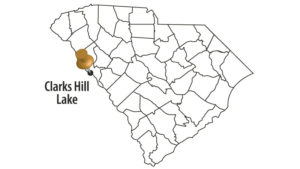 How To Get There
How To Get There
